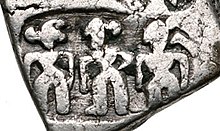
Back একনংশা Assamese একানংশা Bengali/Bangla Ekanamsha French એકાનંશા Gujarati ಏಕನಂಶಾ Kannada ଏକାନଂଶା OR ਇਕਾਂਮਸ਼ਾ Punjabi Эканамша Tatar


Ekanamsha (Sanskrit: एकानंशा; Ekānaṁśā) is a Hindu goddess. She is primarily identified with the illusory power of Vishnu is Yogamaya. [3]
The goddess is believed to have been worshipped by the Vrishnis.[4] Many "kinship triads", depicting Vasudeva Krishna, Balarama, and their sister Ekanamsha have been found in the Mathura region, which are stylistically dated to the early centuries of the Common era.[5] She is believed to have also reincarnated as the goddess Subhadra, the daughter of Vasudeva and Rohini.[6]
- ^ Paul, Pran Gopal; Paul, Debjani (1989). "Brahmanical Imagery in the Kuṣāṇa Art of Mathurā: Tradition and Innovations". East and West. 39 (1/4): 116–117. ISSN 0012-8376. JSTOR 29756891.
- ^ Gupta, Vinay K. "Vrishnis in Ancient Literature and Art". Indology's Pulse Arts in Context, Doris Meth Srinivasan Festschrift Volume, Eds. Corinna Wessels Mevissen and Gerd Mevissen with Assistance of Vinay Kumar Gupta: 70–72.
- ^ www.wisdomlib.org (2017-12-13). "Ekanamsha, Ekānaṃśā, Eka-anamsha: 9 definitions". www.wisdomlib.org. Retrieved 2022-09-12.
- ^ Bhattacharji, Sukumari (2000).The Indian Theogony: Brahmā, Viṣṇu and Śiva, New Delhi: Penguin, ISBN 0-14-029570-4, p.173
- ^ Singh, Upinder (2008). A History of Ancient and Early Medieval India: From the Stone Age to the 12th Century. Delhi: Pearson Education. pp. 436–7. ISBN 978-81-317-1677-9.
- ^ Knapp, Stephen (2005). The Heart of Hinduism: The Eastern Path to Freedom, Empowerment, and Illumination. iUniverse. p. 126. ISBN 978-0-595-35075-9.
© MMXXIII Rich X Search. We shall prevail. All rights reserved. Rich X Search